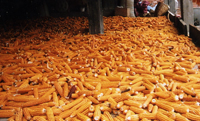Economic Structure
The general economic and social structure of Ordu is dependent on the hazelnut and hazelnut farming. Since hazelnut revenue makes up the most of the annual gross revenues and economic revenues, our city is subject to significant fluctuations in economic activities associated with yield fluctuations during hazelnut farming due to natural causes as well as problems with hazelnut purchase and marketing. Our city's GDP Per Capita is around 1.375, ranked 58th in development list among all cities with its development rate of -5.6.
Agriculture
 The surface area of the city is 656,300 hectare. Out of it, 332,840 hectare is agricultural land, 184,652 hectare is "forest-heathland", 79,000 hectare is "meadow and pasture", 59,800 hectare is "Non-Agricultural Land".
The surface area of the city is 656,300 hectare. Out of it, 332,840 hectare is agricultural land, 184,652 hectare is "forest-heathland", 79,000 hectare is "meadow and pasture", 59,800 hectare is "Non-Agricultural Land".
Our city does not have rich options in terms of agricultural potential, since a major part of the land is rugged terrain and covered with forests. The land structure being not suitable to the garden and vegetable farming made the hazelnut the main financial source of the city. Therefore, in the city, agricultural plants farming and fruit and vegetable farming is of secondary importance.
In our city hazelnut farmers of more than 110,000 produce 166,031 ton of hazelnut on average. An average of 25-30% of Turkish hazelnut production take place in our city.
In terms of planting area among the garden produces, grains take the first place in our city and also Turkey. Followed by pulses in Turkey, tuber plants in our city. In terms of production, in Turkey grains take first place, followed by industrial plants. In our city, tuber plants take first place followed by grains (according to data of Chamber of Commerce and Industry).
Husbandry comes after the agriculture. Husbandry take place in the towns and villages which remains especially south of the city, with lower potential of agricultural production, but having the pastures suitable for husbandry. Husbandry done by small family business and having lower animal potential made it have a limited contribution in the city economy.
Apiculture which is only done by families to meet their own needs has been done in modern hives and mobile methods since 1960. According to Provincial Directorate of Agriculture, our city ranked second in Turkey in terms of the number of hives and first in Turkey in terms of total honey production and honey yield per hive.
Industry
 While economy of our city is mainly based on agriculture and husbandry, some industries have been developing, notably of food industry.
While economy of our city is mainly based on agriculture and husbandry, some industries have been developing, notably of food industry.
When looked at the industry profile of the city, hazelnut cracking, processing, integrated facilities comes at the top with a share of 30%. Followed by food industry with a share of 20% consisting of flour and feed facilities, confectionary, halva-turkish delight facilities, diary and diary products, liquid oil facilities, fish and fish products, beverage businesses, and stone and soil-based industrial facilities with a share of 12%.
Small Industrial Zones, and Organized Industrial Zones which form the basis of the industry are very important for the economy of the city in order to ensure a health development of industry of the city.
Textile industry stands out as an industry starting to develop in the recent years. Having a wide range of products, in our city, lacework business has a special status.
Also having a high potential of forestry resulted in a development of Forest products industry.

